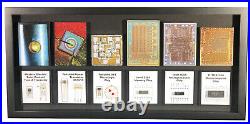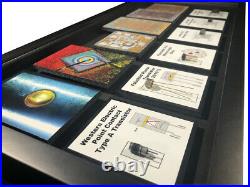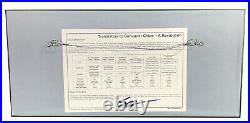The Transistor to Computer Chips Type A, 2N1613, Micrologic, 3101,4004, TMS1000




This collection of six electronic devices spans a period of about 20 years and represents the greatest advances in tools for the human mind than any other period of history. The invention of the transistor was a pivotal point in human history, and the invention of the 2N1613 planar transistor was the key enabler of the computer revolution. The next logical step was to build multiple integrated devices on a single piece of silicon; this was Fairchilds Micrologic family. Intel followed with the first memory chip built with planar transistors, the 3101. Intel quickly followed with the first microprocessor. Texas Instruments TMS1000 was the first computer on a chip combining RAM, ROM, clocks, and I/O support. Today we have billons of transistors on a single chip, but the developments since these key devices have been larger degrees of integration, denser transistor counts, and faster speeds.
These devices led the way. The devices included in this artwork all new-old-stock. The FIrst Transistor: An early 1950s development version of the Bell Labs Type A transistor (A1698, 2N22). The development serial number is handwritten on the top of the transistor. The First Planar Transistor: A Fairchild 2N1613 Planar Transistor.
The First Monolithic Integrated Circuit: A Fairchild Micrologic 914 Dual NOR logic chip (Glob top). The First Solid State Memory Chip: An Intel P3101A gray memory chip. The First Microprocessor Chip: An Intel P4004.
The First Microcomputer Chip: A Texas Instruments TMS1000NLL. The devices have ChipScape artworks above them. All, except the the Type A Transistor, are microscopic photos of the chips. The Type A Transistor photo is a macro photo of the hole through the canister.Through the hole, you can see the germanium slab with the two whisker wires touching it. The yellow color is resin.
Each of the devices has a labeled technical outline of the electrical connections for their leads. The devices in this artwork represent the key milestones in the development of the microcomputing revolution. They enabled the personal and mobile aspects of computing. This artwork is a great piece of history for nostalgia and education. The artwork is framed in a 9"x20" black shadow box frame, with glass.All framing materials are acid free. A narrative about the artwork that includes the artists signature is placed on the back of the artwork.
Want to see more ChipScapes? Computer chips start out as ordinary sand, which is silicon dioxide. However, the silicon must be made very, very pure. The first step is to melt the sand, in a furnace that reaches about 3200. F, and mix with carbon. This first purification process creates 99% pure Silicon, a common output is Silicon Carbide. The Silicon Carbide is processed in a trichlorosilane distillation method to create 99.9999% pure silicon called polycrystalline silicon. The polysilicon is broken up into chunks.These chunks are melted in a crucible at about 2500. A silicon crystal seed is dipped in molten silicon and slowly drawn out to create a cylinder of silicon. These silicon cylinders are some of the purest crystals on the planet. Once the silicon cylinder is grown to the desired diameter, it is sawed into wafers. These wafers are polished to achieve a very flat mirror surface.
Transistors, and other micro-electronic parts, are built on the polished wafer in layers in a process called etching. The wafer is then sawed into its individual chips. Each chip is mounted in an electronic package that serves to protect it and connect it to the outside world. It has been said that computer chips are the greatest value added product in the world. We essentially take a pile of sand and change it into thousands of dollars worth of computer chips. These artworks are the creation of ChipScapes. Are photographs taken of computer chips, boards, and other computer artifacts.They are sort of chip landscapes, or ChipScapes for short. Most often a macro-lens or microscope is used with special lightning to achieve these unique artworks.
Intel, IBM, Fairchild, DEC, Signetics, Intersil, AMD, Zilog, Motorola, MOS, NEC, Texas Instruments, are some of the great chip making companies. Chips like the Intel 4004, MOS 6502, Zilog Z80, AMD 2901, IBM PowerPC and others have changed the way people work and play. Are dedicated to preserving and sharing these computing and communication technologies that changed the world. Artworks are fine collectible artworks.Come is a variety of shapes sizes and colors. Clusters of my artwork make for stunning displays!
A ChipScape would make a great gift for the nerd, geek, engineer, programmer, IT executive, or just that technology savvy person in your life. If you are interested in art on a subject or chip that you don't see listed, please message me.I have hundreds of artwork and cannot keep them all listed. Also, I do custom artworks. If I think it will be of general interest, the pricing will be similar to what you see in my store.
If it is very specific to your interests the pricing will be higher, since I can't spread the development costs over multiple sales. For more information about ChipScapes. For more information about chip collecting as a hobby. The item "The Transistor to Computer Chips Type A, 2N1613, Micrologic, 3101,4004, TMS1000" is in sale since Friday, May 14, 2021.
This item is in the category "Art\Mixed Media Art & Collage Art". The seller is "chipscapes" and is located in Winter Park, Florida.
This item can be shipped worldwide.
- Size: Medium (Up to 30in.)
- Materials: Paper, Silicon, Metal
- Style: Impressionist
- Type: Collage
- Original/Reproduction: Limited Edition
- Subject: Computer Chips
